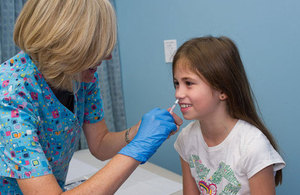Child flu vaccine pilot has positive impact
Early results from the 2013 to 2014 child flu vaccine pilot programme suggest a positive impact on levels of flu.

Initial results of the uptake and impact of the child flu vaccine pilot programme launched last year by Public Health England (PHE) are encouraging, according to an article published in Eurosurveillance.
In 2012 the Joint Committee on Vaccination and Immunisation advised extending the national flu immunisation programme to all children from the age of 2 to less than 17 years.
In addition to protecting healthy children from flu, the extension aimed to reduce the spread of flu and protect younger siblings, grandparents and those who are at increased risk of becoming seriously ill from flu.
As a first step in the extension of the programme, last year all children aged 2 and 3 years were offered flu vaccination, while children aged between 4 and 11 years old were vaccinated in 7 pilot areas in England in 2013 to 2014.
Pilots took place in Bury, Cumbria, Gateshead, Leicester City, East Leicestershire and Rutland, and the London Boroughs of Havering and Newham and South East Essex. A total of 104,792 primary age children received at least 1 dose of a nasal spray flu vaccine, or a needle vaccine for the small number of children unable to receive the nasal spray vaccine.
This represents an overall uptake of 52.5% in the target group.
Despite the low flu activity in 2013 to 2014, early results, although statistically non-significant, suggest a positive impact. Results were obtained from a range of surveillance indicators including GP consultations for influenza-like illness, swab positivity in primary care, laboratory confirmed hospitalisations and percentage of respiratory emergency department attendances.
The cumulative GP consultation rate for ‘influenza like illness’ over the 2013 to 2014 season was higher in non-pilot (64.5/100,000) compared to pilot areas (17.7/100,00).
The cumulative influenza positivity rate in primary care in pilot areas was 8.5% compared to 16.2% in non-pilot areas.
The cumulative proportion of emergency department respiratory attendances was 5.5% in pilot compared to 8.7% in non-pilot areas.
From September 2014 vaccination against flu will be offered to all children aged 2 to 4 years of age. The geographical pilots for primary school children established in 2013 to 2014 will continue and a number of additional pilots for secondary school age children in years 7 and 8 (ages 11 to 12) will also begin in some areas.
Dr. Richard Pebody, study author and flu expert at PHE said:
These early results of the uptake and impact of the first year of the childhood flu vaccine programme are encouraging and the uptake levels already achieved in primary school age children this season in the pilot areas are positive.
Despite this season being of relatively low intensity, these early findings already suggest a likely impact of vaccinating school-age children on levels of circulating flu, which is encouraging for the on-going roll-out.
It will be important we continue this on-going close monitoring of the programme, but the high uptake levels achieved in most pilot areas using school-based delivery demonstrate the feasibility of achieving high coverage levels.
Dr Paul Cosford, Director for Health Protection and Medical Director at PHE, said:
This is an important addition to the national programme and is being carefully planned. The pilots are helping us to understand the best way to implement the programme nationally, ensuring that we can set up a successful and sustainable programme, vaccinating children and young people to protect them and the wider population.
Ends
Notes to editors
- Full article is available from Eurosurveillance.
- The seasonal flu vaccination programme is based on independent expert advice from the Joint Committee on Vaccination and Immunisation (JCVI). The aim of the current flu vaccination policy is to reduce the serious morbidity and mortality due to flu by immunising those people most at risk of serious illness or death should they develop flu. This is in line with most other countries that have seasonal influenza vaccination programmes.
- Pilots were designed to test which delivery method is the most efficient and is well-accepted by parents and children, and not to test the vaccine which has a long track record in the US. Posters highlighting ‘Which flu vaccine should you or your child have’ and ‘5 reasons to get your child vaccinated against flu’ are available online.
- Public Health England’s mission is to protect and improve the nation’s health and to address inequalities through working with national and local government, the NHS, industry and the voluntary and community sector. PHE is an operationally autonomous executive agency of the Department of Health.
www.gov.uk/phe Follow us on Twitter @PHE_uk
UKHSA press office: National Infection Service
UKHSA press office, infectious diseases
61 Colindale Avenue
London
NW9 5EQ